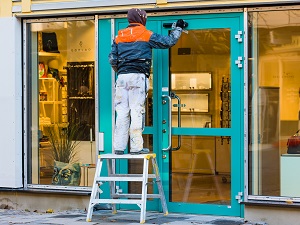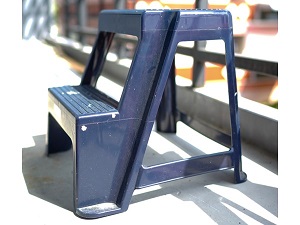With a fixed height up to 32 inches tall, step stools may seem safe but require many of the same safety precautions of full-size step ladders.

A step stool refers to a smaller self-supporting, portable ladder, that may be foldable for easy storage. Step stools are useful and efficient when extra height is needed to reach or perform tasks overhead safely but when a full-sized ladder is not required.
Unlike step ladders, step stools do not have a pail shelf and are designed in a way that allows a person to stand on the top step, also known as the top cap.
OSHA Requirements for Step Stools
OSHA General Industry Standard 1910.23(b)(3) Steps on stepstools are spaced not less than 8 inches apart and not more than 12 inches apart, as measured between the centerlines of the steps. (4)(iv) Stepstools have a minimum clear width of 10.5 inches.
OSHA Construction Standard 1926.1053(a)(3)(ii) Rungs, cleats, and steps of step stools shall be not less than 8 inches apart, nor more than 12 inches apart, as measured between center lines of the rungs, cleats, and steps.
Step stools are a fixed height of up to 32 inches tall. A step stool is measured along the front side rail from the bottom of the feet to the top step. Side rails may extend above or over the top step but any rails above the top step are not included in the overall height measurement of the step stool.

Proper Step Stool Setup and Safe Use
Always set up and use the step stool according the manufacturer’s instructions. Before using any step stool for the first time, review all warning labels and instructions on the step stool and read the owner’s manual for guidance on proper use and safety precautions.
To be used safely, a step stool must be placed on level ground with solid floor support for all four feet, or the entire base. The step stool should be set up close to the work being performed or the area that needs to be accessed. If you begin to climb and feel like the step stool is not balanced properly, climb down and reposition.
Climb and use the step stool in a way that allows your body to be near the middle of the steps to prevent tipping or fall hazards. Avoid over-reaching when on a step stool. Always face the step stool when climbing up or down. Step stools are intended to be used by only one person at a time.
OSHA General Industry Standard 1910.23(c)(3) The employer must ensure that ladders are not loaded beyond the maximum intended load.
OSHA Construction Standard 1926.1053(b)(3) Ladders shall not be loaded beyond the maximum intended load for which they were built, nor beyond their manufacturer's rated capacity.
Ensure that the step stool you are planning to use is sturdy and able to support the intended weight of the task. The maximum intended load includes the weight of the employee as well as the PPE worn, and all tools, equipment and materials being carried.

Using a Step Stool Safely
Do not use a step stool in a closed position, like a small extension ladder, or in a partially open position. Every time a step stool is used, the base must be spread fully open with the spreaders locked. Always ensure the locking mechanism is engaged before climbing.
Never attempt to move the step stool while standing on it, or by standing on something else (like a shelf) and pushing the step stool with your foot. Always get down from the step stool and move it to the next secure and stable location you need to use it before climbing on again. Always climb onto a step stool from the front. Do not climb onto a step stool at an angle or from the side or back. Never climb or stand on the braces at the rear of the step stool.
Because step stools are not fixed ladders, do not step onto a step stool from another platform. For example, do not climb from one step stool to another step stool in order to save time.
Step stools should never be used on any slippery surface or on snow or ice.
When using, do not place a step stool on top of another object like boxes, a barrel, scaffolding, or shelving. If additional height is required, use a ladder more suitable to the task that can be used safely.
Other objects that you may be inclined to step on, like chairs, boxes, bins, filing cabinets or shelves, are not suitable replacements for a step stool and should not be used in that manner.

Inspecting Your Step Stool
Always inspect the step stool prior to each use, or at minimum before the first use on each shift. During the step stool inspection, you are checking that all parts of the step stool are in good working condition, including:
- all four anti-slip feet, or the anti-slip base
- climbing/gripping surfaces on each step
- step-to-side rail connections
- working parts, bolts, rivets
OSHA General Industry Standard 1910.23(b)(9) Ladders are inspected before initial use in each work shift, and more frequently as necessary, to identify any visible defects that could cause employee injury.
OSHA Construction Standard 1926.1053(b)(15) Ladders shall be inspected by a competent person for visible defects on a periodic basis and after any occurrence that could affect their safe use.
If any step stool is found to have missing or broken components, structural damage, or a hazardous defect, it must be removed from service immediately. Step stools that have been exposed to excessive heat or corrosive substances, may have reduced strength and should be removed from service. The step stool should be tagged with “Do Not Use” (or similar) and then either discarded or properly repaired. A step stool with bent or broken side rails must be removed from service. If a defective step stool will not be repaired, and must be discarded, it should be broken down or destroyed in such a way that ensures that no other person may find and use the unsafe step stool.

Step Stool Storage
Before putting away, hanging or storing any step stool, ensure that it is relatively clean. If a step stool has been in contact with oil, grease or any other material that may cause it to become slippery when used, carefully clean the step stool to ensure it resumes its original, safe condition.
Never leave a step stool set up and unattended, especially if there is any chance of children passing through the work area. Unattended step stools can also become a tripping hazard for other workers and are best stored away when not in use.
Step stools that are available to workers to use should be stored securely out of the way in an area that still remains accessible and convenient. While in storage, do not store other materials on top of any step stool.


.jpeg)
